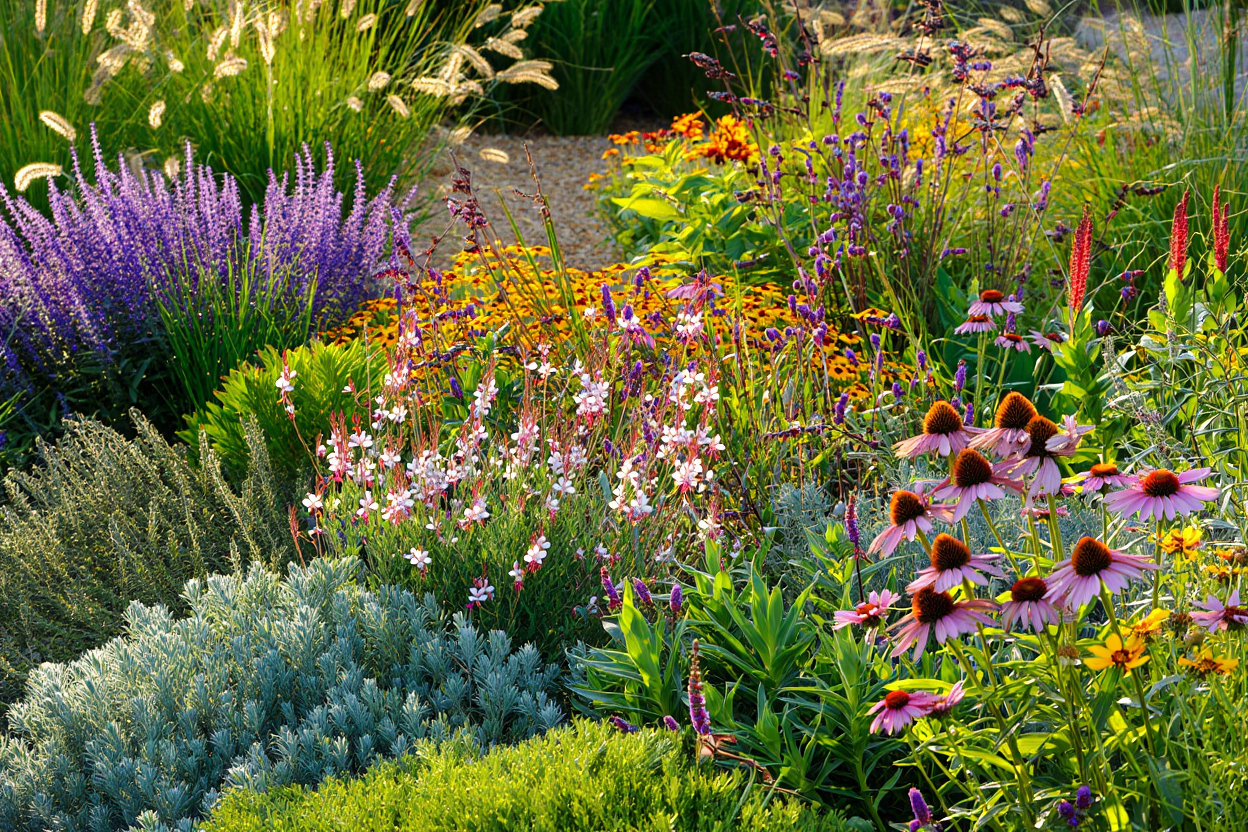
You’ve probably noticed it — every garden tag, nursery sign, and online list these days seems to brag about being “drought-tolerant.” It’s the gardening buzzword of the decade. But here’s the catch: a lot of those so-called “water-wise” plants still guzzle more moisture than you think.
In trials across the U.S., researchers found that many popular “low-water” perennials — like lavender, Russian sage, and Gaura — actually wilt or lose bloom quality when soil moisture drops below 50% of field capacity (Frontiers in Ecology, 2024). Even the University of Arizona Cooperative Extension puts it plainly: most so-called drought-tolerant shrubs still need consistent deep watering for at least two growing seasons before they can truly fend for themselves (extension.arizona.edu) — far from the “set it and forget it” promise.
It’s no wonder so many gardeners feel misled. You follow the advice, plant the “tough” species, and still end up hauling hoses through August. The truth is, most of these plants weren’t bred for our soils or humidity — they evolved in dry climates with cool nights, sandy soil, and steady air circulation. Drop them into a humid summer or compact clay, and they struggle.
The real drought-tolerant champions? They’re the ones that evolved right here. Native prairie perennials, desert shrubs, and regional wildflowers that can power through heatwaves, erratic rain, and poor soil without begging for attention.
So before you buy another “water-wise” wonder that turns needy by July, here are 12 popular plants sold as drought-tolerant that aren’t nearly as tough as they claim — and the native swaps that actually live up to the promise.
1. English Lavender (Lavandula angustifolia)
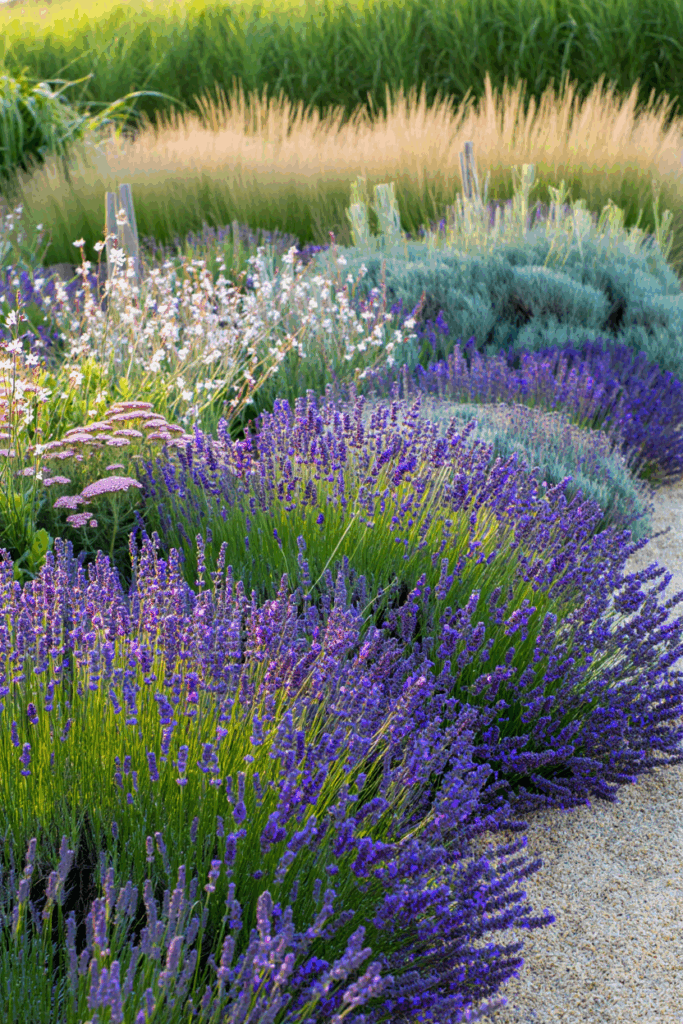
It’s easy to see why English lavender ends up on every drought-tolerant list. Those silvery leaves, purple blooms, and that soft herbal scent make it look like the perfect low-water plant. But the truth is, its “drought-proof” reputation doesn’t really hold up once you take it out of the Mediterranean.
In its native range, lavender grows in rocky hillsides that get long, gentle winter rains and mild, dry summers. That balance of deep winter moisture and slow summer drying just doesn’t happen in most U.S. gardens. Here, the sun and wind pull moisture out of the topsoil fast — and that’s exactly where lavender’s fine roots live. Once the soil dries below about ten percent moisture, the plant starts to struggle. Growth slows, leaves brown, and woody dieback follows. Researchers have even documented how lavender’s metabolism shuts down under extended drought stress — it stops making chlorophyll and proteins just to survive. You can read the full study here.
Even mature plants need a good deep soak every week or so in inland heat, and heavy soil or summer humidity can finish them off with crown rot. So yes, lavender likes things dry — but not that dry.
A Better Native Alternative – Blue Sage (Salvia azurea)
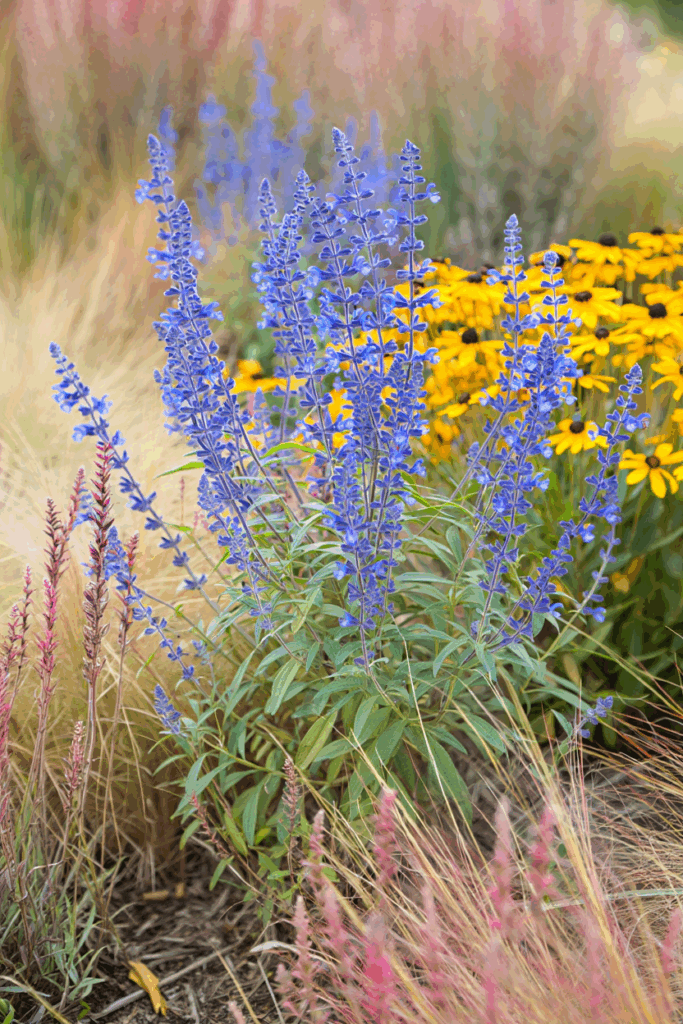
If you love lavender’s silver-green look and graceful upright form, Salvia azurea is your American answer. Native to the central and southern Great Plains, it’s built for true drought. Once established, its deep roots reach moisture far below the surface, so it keeps blooming long after lavender gives up. The narrow, gray-green leaves and tall spikes of sky-blue flowers bring the same calm, cottage feel — but without all the fuss. Bees and butterflies adore it, and it shrugs off heat, wind, and poor soil like it was made for it — because it was.
2. Gaura (Oenothera lindheimeri)
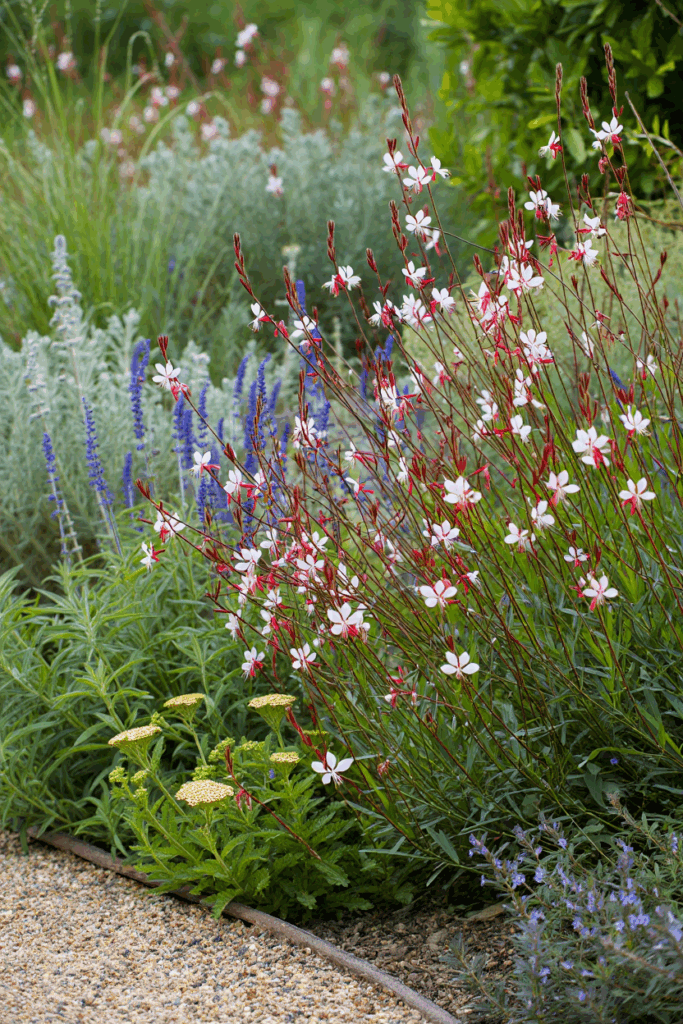
At first glance, gaura seems like the perfect low-water plant. Those dancing pink-and-white flowers sway above wiry stems all summer, looking carefree even in the heat. It’s often sold as a drought-tolerant perennial for tough spots — and in mild conditions, it behaves that way. But in true drought, gaura tells a different story.
The truth is, this plant prefers steady soil moisture at the root zone. Once the ground dries out completely, the flower spikes droop, buds abort, and the whole plant can collapse within days. Gaura’s long taproot helps it survive short dry spells, but it still needs a deep soak roughly every ten to twelve days to keep blooming through midsummer. In heavier clay soils, those roots also struggle to breathe, which leads to sudden dieback. A layer of mulch helps, but it’s not a replacement for occasional watering when conditions stay hot and dry for weeks.
A Better Native Alternative – Winecup (Callirhoe involucrata)

If you love gaura’s airy movement and long bloom season, Callirhoe involucrata, or winecup, gives you all that charm with far more drought resilience. This sprawling native wildflower thrives in full sun and poor, rocky soil where gaura fades fast. Its magenta cup-shaped blooms open for months and close each night, adding a little rhythm to the garden. Once established, winecup forms a deep taproot that lets it ride out long dry periods without flinching. It’s also a favorite of native bees and butterflies — and you’ll never need to drag the hose out just to keep it alive.
3. Rosemary (Rosmarinus officinalis)
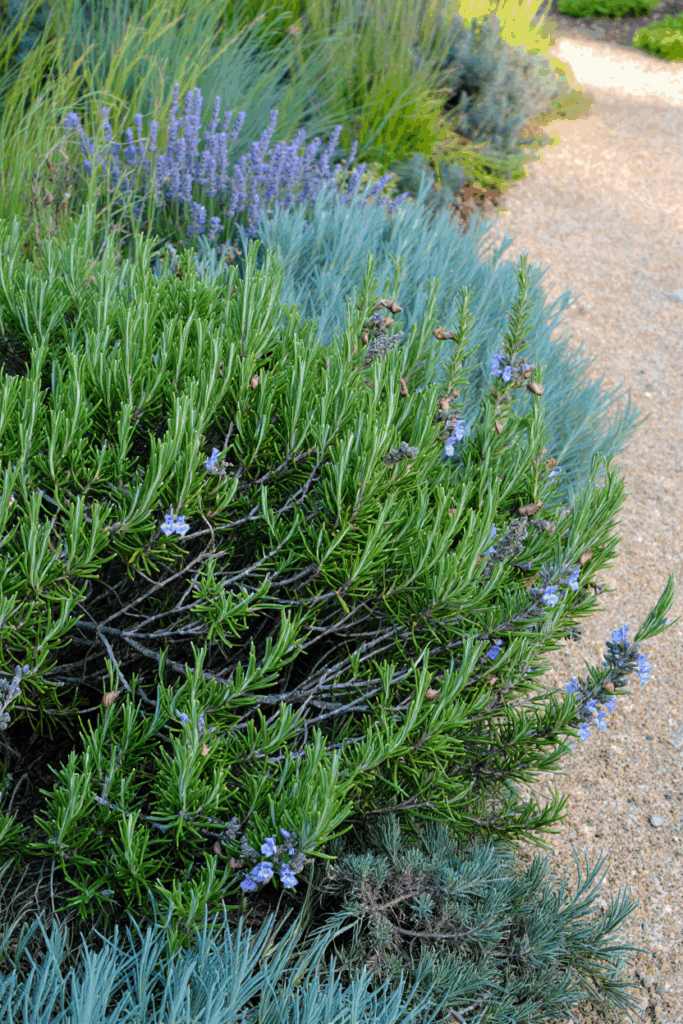
Rosemary’s reputation for drought toughness is a little misleading. It’s true that it hails from the Mediterranean, where summers are dry, but that kind of “dry” isn’t the same as what most of us deal with in North America. Mediterranean droughts come with cool nights, sea breezes, and deep winter rains that recharge the soil. Our inland summers bring relentless sun, hot wind, and no humidity — conditions that pull moisture out of both soil and leaves faster than rosemary can keep up.
When the heat lingers, rosemary doesn’t wilt dramatically; it dries from the inside out. The needles stay green for a while, but inside, the woody stems turn brittle and die back. Once that happens, recovery is rare. A deep soak every seven to ten days during long heatwaves helps keep the root zone cool and prevents that hidden dieback. Mulching lightly around the base (but never against the woody stems) can also stabilize soil moisture and temperature.
A Better Native Alternative – ‘Powis Castle’ Artemisia (Artemisia arborescens × absinthium)
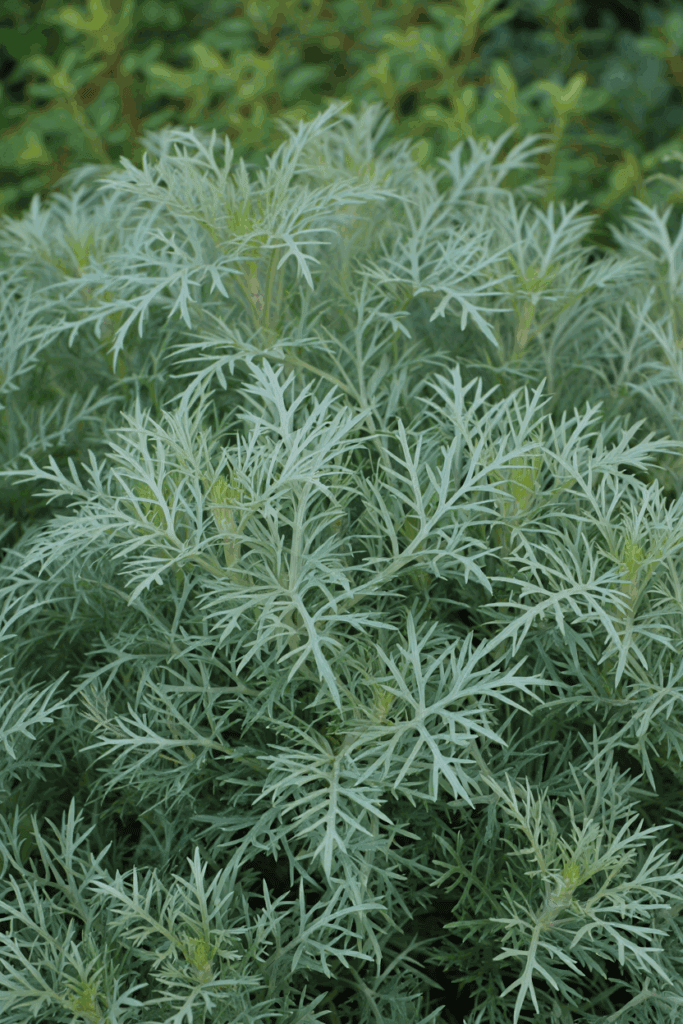
If you love rosemary’s fine texture and silvery-green color, Artemisia ‘Powis Castle’ gives you the same visual calm without the heartbreak. Its feathery leaves shimmer in sun, releasing a soft herbal scent when brushed, and it thrives in full sun and lean, dry soil. Once established, it’s remarkably heat-tolerant and can go weeks without rain. Unlike rosemary, it doesn’t sulk in humidity or freeze back as easily in colder zones.
4. Agastache (Agastache foeniculum, A. rupestris)
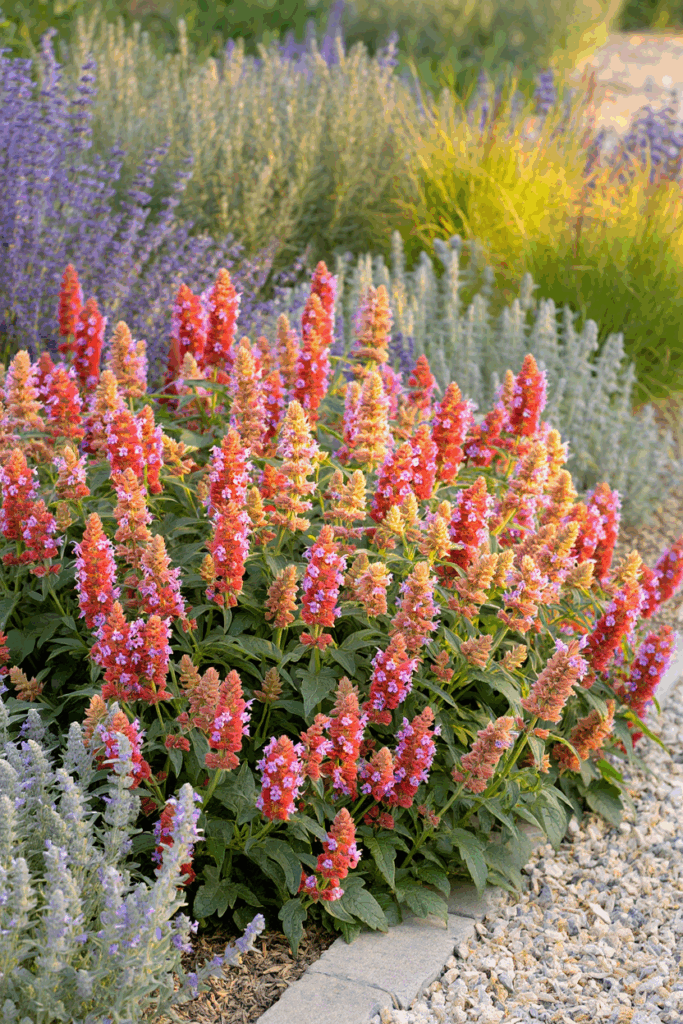
Few plants look more at home in a dry, sunny border than Agastache. With its tall spikes of coral, lavender, or violet blooms and that sweet licorice scent, it’s no wonder people call it “hummingbird mint.” Catalogs love to call it heat-proof and xeric, but that’s only half true. Agastache can survive on neglect — it just won’t look good doing it.
In long dry spells, the top growth begins to crisp, and the flowers stop producing nectar. The leaves lose their fragrance as essential oils break down under stress. Deep watering every week or ten days during high heat keeps the root zone cool and the plant actively blooming. Skip it, and you’ll still have a living plant — just one that looks tired and stops attracting pollinators. Agastache’s roots are shallow and fibrous, so they depend on a bit of stored soil moisture to keep those nectar-rich spikes coming.
A Better Native Alternative – Spotted Beebalm (Monarda punctata)
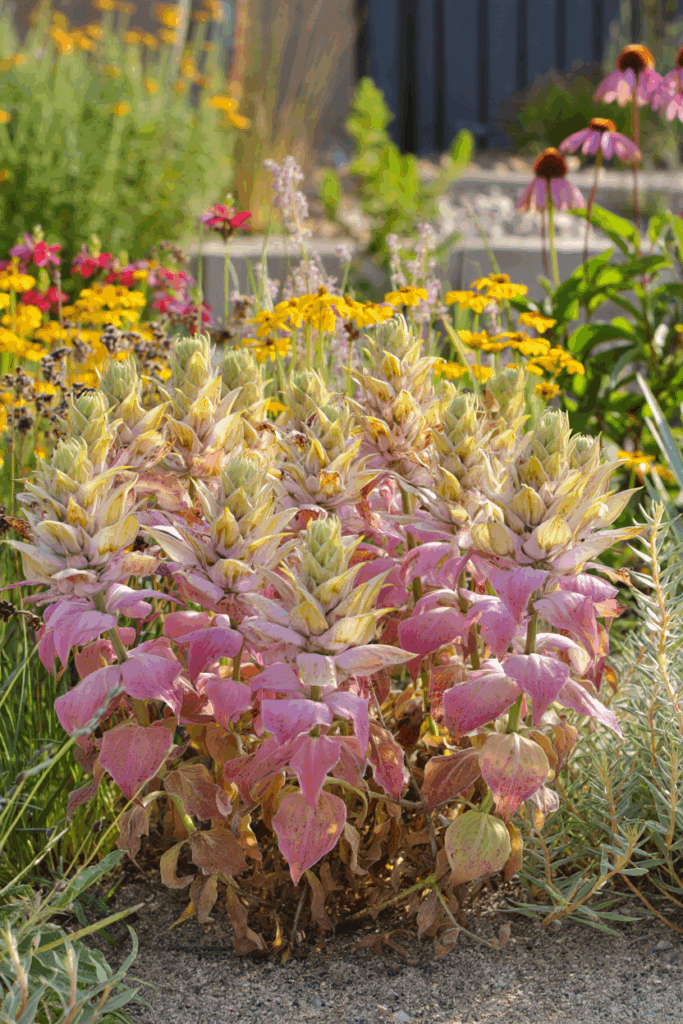
For a truly drought-tough native that still buzzes with life, Monarda punctata — also known as spotted beebalm or horsemint — is hard to beat. It shares Agastache’s tall, aromatic form and pastel bloom spikes, but it evolved for dry prairies and sandy soils across the eastern and southern United States. Once established, its deep roots and natural oils help it sail through heat waves without missing a beat.
Spotted beebalm’s layered whorls of pink and cream flowers attract the same hummingbirds and native bees Agastache is famous for — only it keeps feeding them when the rain stops.
5. Butterfly Bush (Buddleja davidii)

Butterfly bush is one of those plants that seems to promise everything — clouds of purple blooms, a sweet scent, and butterflies fluttering around all summer. It’s often sold as a drought-tolerant shrub, but in truth, it only thrives when the soil stays evenly moist. The first season or two it performs beautifully, then as the ground dries out year after year, the stems get brittle and flowering slows.
The confusion comes from where it evolved. In its native range of central China, summers are warm and rainy, not arid. The plant depends on steady moisture in the root zone to keep pushing out those heavy flower clusters. Without it, the buds dry before opening, leaves curl, and the whole shrub starts to die back from the base. Deep watering every week or two during summer droughts can help, but that’s hardly “no maintenance.” In addition, butterfly bush has naturalized aggressively across parts of the Pacific Northwest and Northeast, where it escapes cultivation and crowds out native nectar sources.
A Better Native Alternative – California Lilac (Ceanothus spp.)
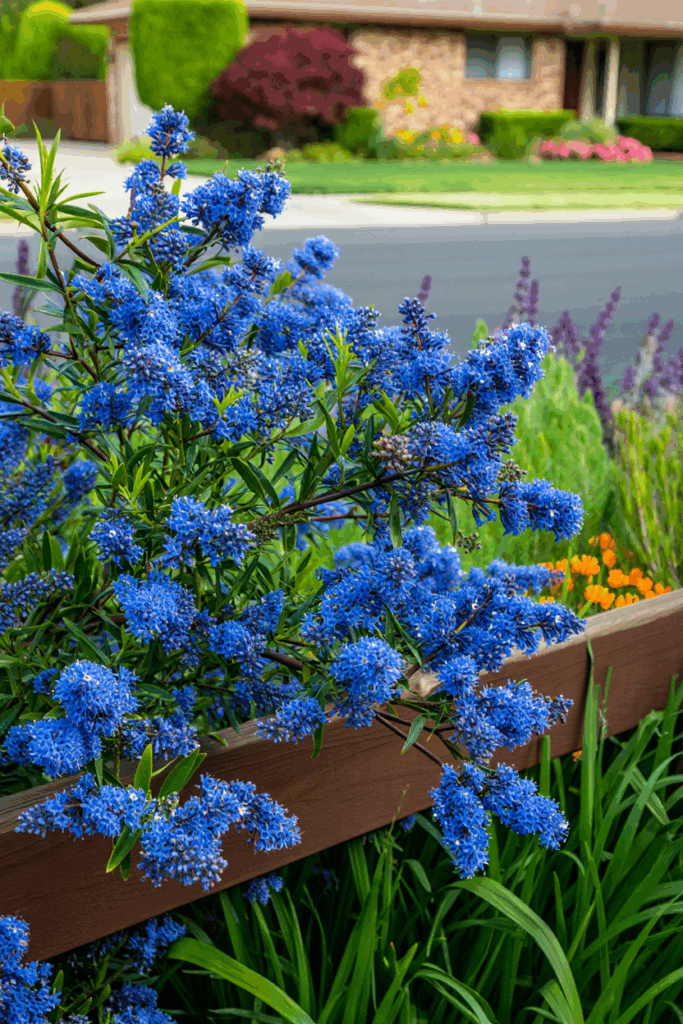
If you want the same haze of blue and purple blooms and that sense of movement alive with bees, Ceanothus delivers it naturally. This West Coast native is a true drought survivor, rooted in dry slopes and chaparral soils where summer rain barely exists. Once established, it needs virtually no supplemental watering. The glossy evergreen leaves stay fresh through heat waves, and spring brings hundreds of nectar-rich flower clusters that support native bees, butterflies, and beneficial insects.
6. Purple Coneflower (Echinacea purpurea)
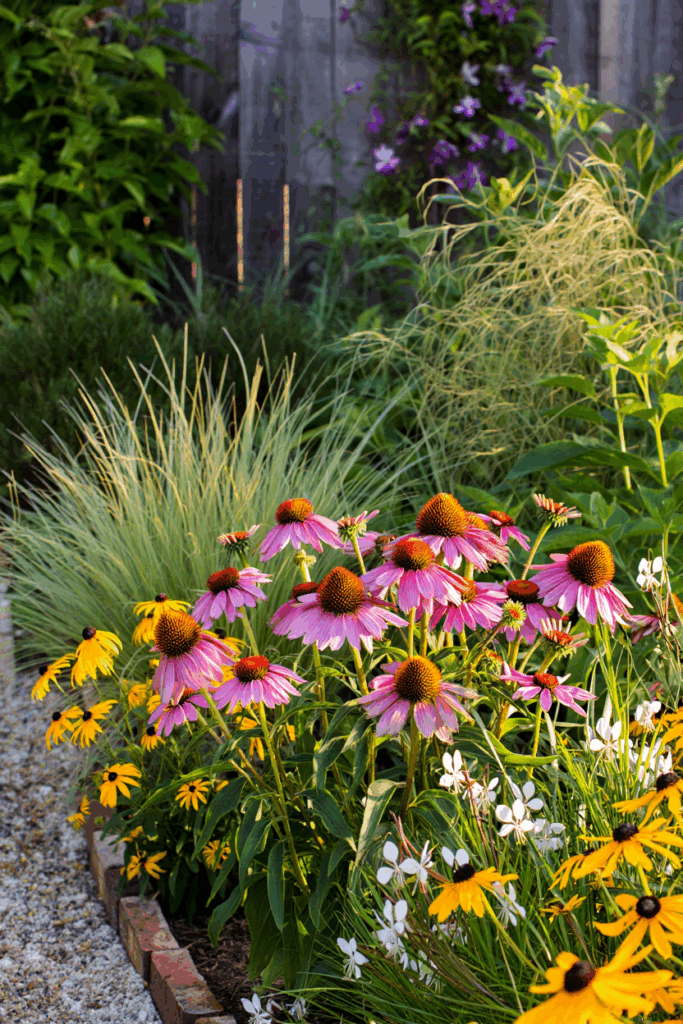
Purple coneflower is often celebrated as a hardy, low-water perennial, and for the first few weeks of summer it lives up to the reputation. Those bold, daisy-like blooms stand tall through heat and wind, and it’s easy to assume the plant can take just about anything. But true drought — the kind where the soil stays dry for weeks — reveals a different story.
In its native range, Echinacea purpurea grows in open woodlands and prairies with deeper, richer soils that hold steady moisture. In hot, dry gardens, its fibrous roots can’t reach enough water once the topsoil dries out. Flowers shrink, stalks droop, and leaves curl under stress. Even mature plants benefit from a deep soak every ten days in summer to stay in bloom. Skip it, and you’ll still have a living clump — just one that stops flowering long before fall.
A Better Native Alternative – Prairie Coneflower (Ratibida columnifera)
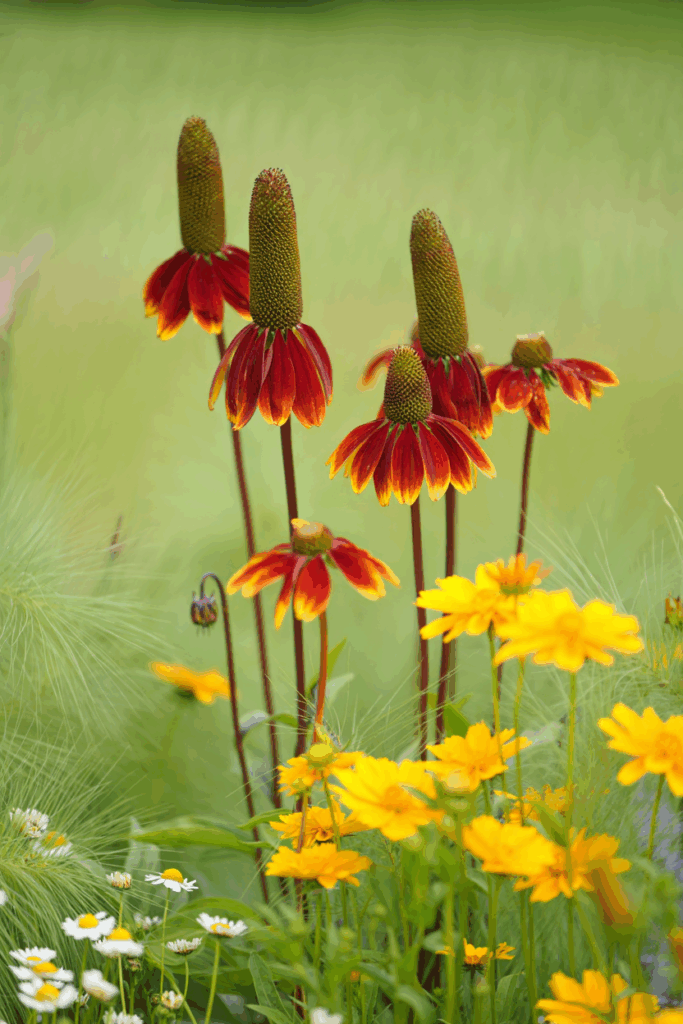
If you love the shape and cheerful look of coneflowers but need something that laughs at dry spells, prairie coneflower is your plant. Native to the central and western prairies, it’s built for real drought. Its deep taproot drives far below the surface to find moisture, allowing it to bloom straight through the hottest weeks of summer. The petals — drooping in the same signature cone shape — glow in shades of yellow, rust, and orange that light up a dry border.
Prairie coneflower brings that same sunny energy and pollinator appeal as Echinacea, but it keeps blooming when others wilt.
7. Spanish Lavender (Lavandula stoechas)
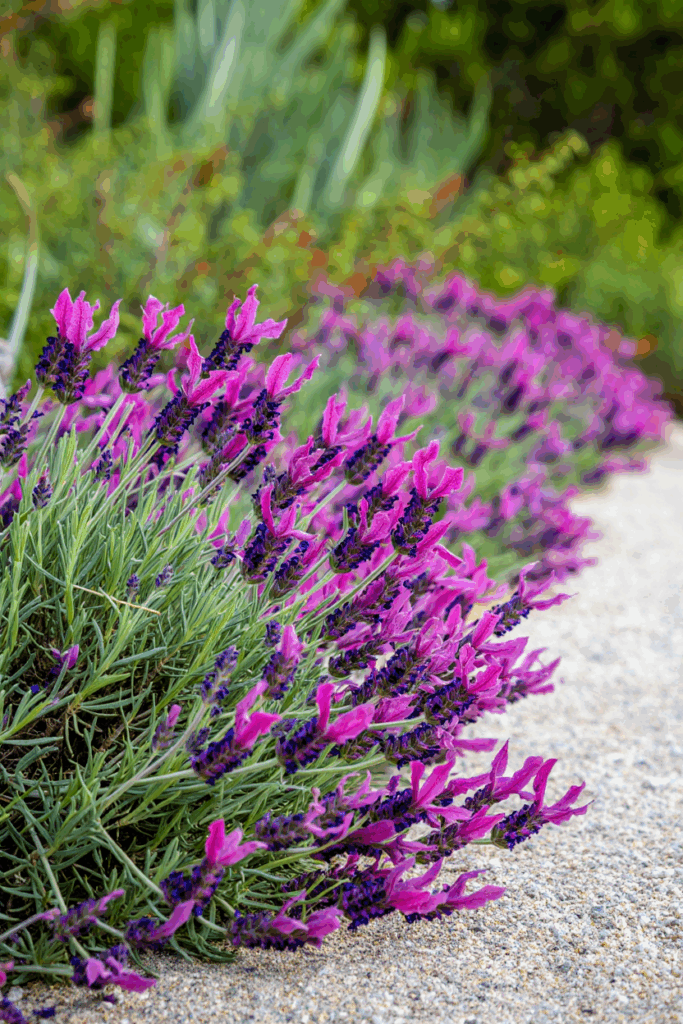
Spanish lavender looks like a plant that could survive anything — dense silver leaves, upright stems, and those adorable “rabbit-ear” blooms that dance in the heat. It’s often sold as a tougher, longer-blooming cousin of English lavender, but the truth is, it’s even less tolerant of stress. In its native coastal Mediterranean range, it grows where summers are warm but moderated by humidity and mild nights. Move it inland or into true heat, and it struggles fast.
Spanish lavender’s fine surface roots dry out quickly, and once the soil stays dry for too long, the lower stems begin to brown and die back from the base. It also dislikes temperature extremes — too much heat, too much cold, or too much wind can all cause decline. Even in well-drained soil, it needs a deep watering about every 10 to 12 days in summer to keep its foliage soft and its blooms upright. It survives drought better than many herbs, but not enough to live up to its reputation.
A Better Native Alternative – Sand Sage (Artemisia filifolia)

For that same silvery shimmer and sculptural form, Artemisia filifolia, or sand sage, is a perfect native counterpart. It’s built for true drought, thriving across the Great Plains and Southwest where rainfall can drop below ten inches a year. The fine, feathery leaves catch the light in the same way lavender’s do, and its soft herbal scent feels right at home in a cottage or xeric border. Once established, sand sage needs virtually no extra water — its deep roots find what they need far below the surface.
8. Blanket Flower (Gaillardia × grandiflora)
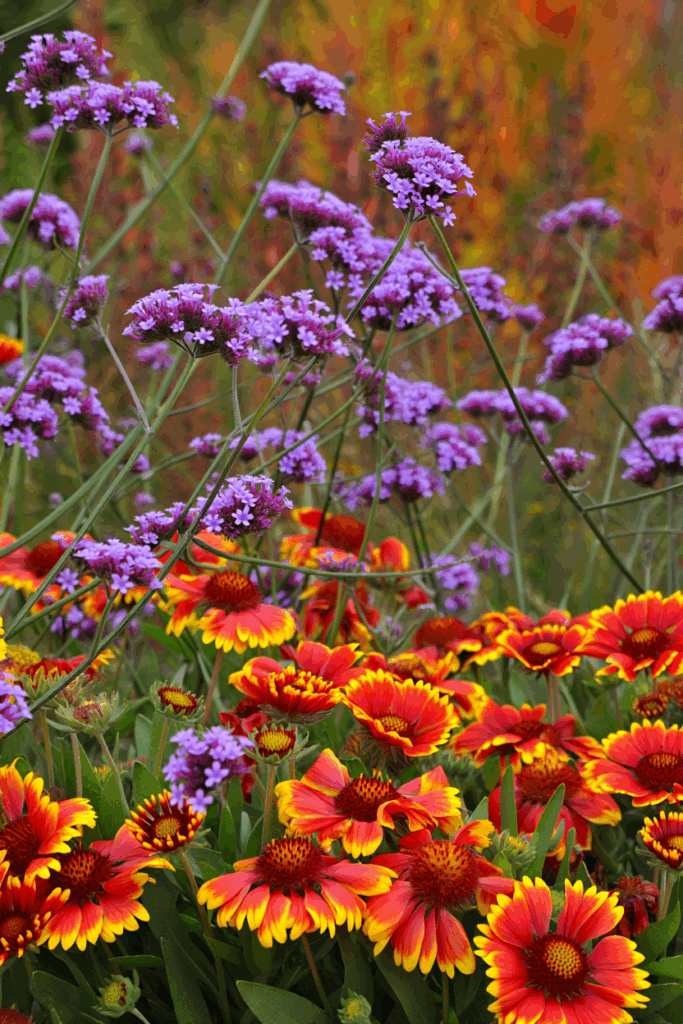
Blanket flower is a favorite in every “tough plant” display — fiery red and gold blooms, nonstop color, and the promise that it thrives on neglect. But while it handles short dry spells, it isn’t a true desert dweller. Most modern hybrids come from mixed parentage, bred for longer bloom rather than pure resilience. That means shallower roots, larger flowers, and a need for more consistent soil moisture than many gardeners realize.
When the ground bakes hard and stays dry, blanket flower quickly shows stress. The petals fade, leaves crisp along the edges, and plants can die back within a few weeks of extreme drought. In sandy or gravelly beds, they do best with a deep soak every ten days to keep their crowns from drying out. Even in perfect drainage, these hybrids are short-lived perennials — they often burn out after two or three seasons if the soil swings between too wet and too dry.
A Better Native Alternative – Angelita Daisy (Tetraneuris acaulis)
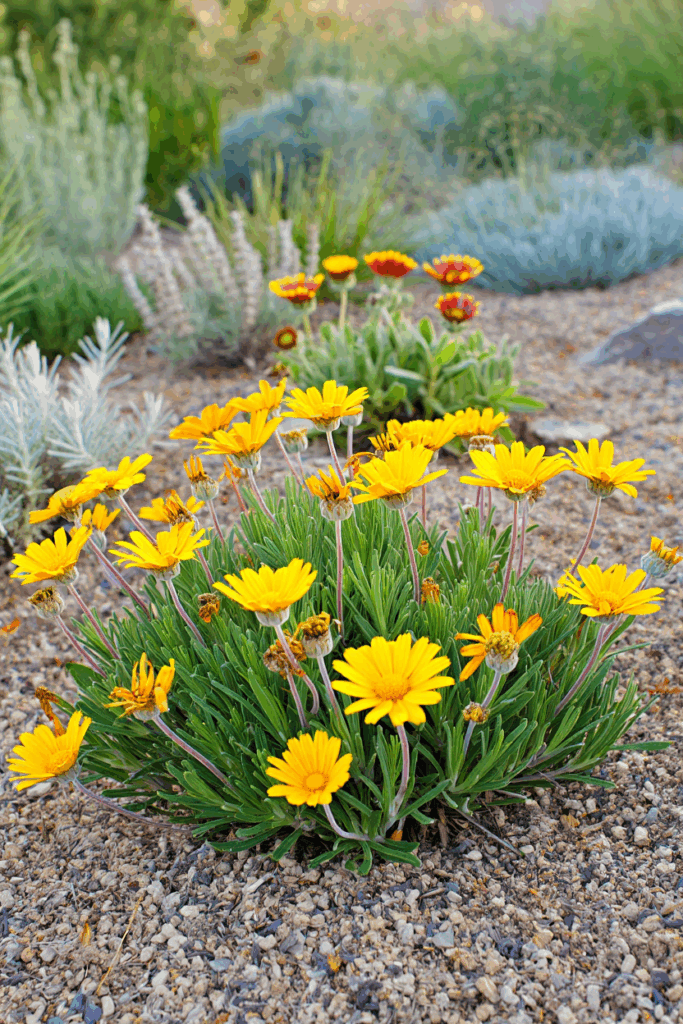
If you love those sun-bright daisy faces but want a plant that truly handles heat and drought, Tetraneuris acaulis, often called angel daisy or stemless four-nerve daisy, is the one to grow. Native to the southern plains and desert foothills, it’s built for extremes — blazing sun, lean soil, and weeks without rain. Its tidy clumps of gray-green foliage stay evergreen through mild winters, and it sends up cheerful yellow blooms from spring through fall with almost no care.
9. Black-eyed Susan (Rudbeckia hirta)

Everyone loves a Black-eyed Susan. Those bright yellow petals and chocolate-brown centers shout summer from across the yard, and the plant’s often sold as the ultimate “drought-tolerant” wildflower. The truth? It’s tougher than most perennials — but it still gets thirsty.
In the wild, Black-eyed Susans grow in open meadows that catch at least occasional rain. Their roots sit shallow, feeding off surface moisture. When that top layer of soil dries out completely, the leaves droop, the flowers shrink, and the cheerful color starts to fade. You’ll see it happen fast in midsummer heat — one week they’re glowing, the next they look like they’ve had enough of August.
A horticultural study that looked at Rudbeckia and similar perennials found that once soil moisture drops below about 20%, the plants begin to shut down leaf activity to conserve water — which is when we see wilting and shorter bloom time (Journal of the American Society for Horticultural Science). In plain terms, they’ll survive a dry spell, but if you want that full flush of flowers, you’ll need to give them a deep soak every week or so when the weather stays dry.
A Better Native Alternative – False Sunflower (Heliopsis helianthoides)

For a longer-lived and genuinely low-water option, Heliopsis helianthoides, or false sunflower, is a standout. It has the same golden color and cheerful, daisy-like blooms but with deeper roots and stronger drought resilience. Native to prairies and open woodlands across much of North America, it handles heat, poor soil, and dry spells with ease once established. The plants live for years instead of seasons and keep blooming steadily through late summer without pampering.
10.Yarrow (Achillea millefolium)

Yarrow has earned a reputation as the ultimate low-maintenance, drought-proof perennial. You see it in every “waterwise garden” display — soft, feathery leaves, flat flower clusters, and that promise that it’ll bloom beautifully without a drop of extra water. And while wild yarrow is genuinely tough, the fancy hybrids most of us buy at the nursery aren’t quite as bulletproof as their labels suggest.
Researchers who’ve tested yarrow under different irrigation schedules found that performance drops sharply when the soil stays dry for too long. In one greenhouse trial, yarrow watered only every two weeks lost more than half its flowers and height compared to plants watered weekly (ResearchGate study). Another study confirmed that drought stress changes how yarrow’s cells function — altering the balance of its polyphenols and slowing photosynthesis (ScienceDirect research).
In plain English? Yarrow can survive drought — it just won’t look good doing it. Once the top few inches of soil bake dry, the leaves crisp from the bottom up, flowers shrink, and stems flop. Even the tough native species appreciates a deep soak every 10–14 days during long dry spells.
A Better Native Alternative – Pearly Everlasting (Pseudognaphalium canescens)

If you love yarrow’s silvery texture and clustered blooms, Pseudognaphalium canescens gives you the same ethereal look with true drought endurance. Native across much of western and central North America, it forms soft silver foliage that glows in sunlight and stays tidy even through long dry spells. In midsummer, it sends up flat clusters of creamy white flower bracts that look almost like dried strawflowers — lasting for weeks and feeding native butterflies, especially the American Lady, whose caterpillars rely on it.
11. Japanese Spirea (Spiraea japonica)

Japanese spirea might be one of the most misunderstood “tough” shrubs out there. Garden centers sell it as heat- and drought-tolerant, the kind of plant you can stick in a sunny spot and forget about. And yes, it can take some dry weather — but not as much as the tag suggests.
What most people don’t realize is that spirea’s fine, fibrous roots live close to the surface, where the soil dries out first. Once that top layer bakes, the tips crisp, flower buds stall, and the shrub starts looking more like a tumbleweed than a landscape staple. Research from the American Society for Horticultural Science found that Spiraea japonica cultivars vary wildly in how they handle drought — some bounce back fast, but others wilt and lose vigor at even mild stress levels (see the study here). Another university trial pointed out that while spirea is fairly tolerant, it still performs best with consistent moisture, roughly the equivalent of an inch of rain a week (Arkansas Extension reference).
So yes, spirea will survive a dry spell — but if you want those soft mounds of pink flowers all summer, it still needs a good soak every five to seven days in the heat. Otherwise, the flowers fade, the stems go woody, and the “easy-care” promise starts to look like false advertising.
A Better Native Alternative – Steeplebush (Spiraea tomentosa)

If you love that frothy pink look but want something that doesn’t need babysitting, Spiraea tomentosa — or steeplebush — is a wonderful swap. It’s native across much of the eastern U.S., and it naturally handles dry spells, rainstorms, and poor soil without complaint. The fuzzy pink flower spikes feed native bees and butterflies through midsummer, and the foliage keeps its silvery tone even when rain is scarce.
12. Russian Sage (Perovskia atriplicifolia / Salvia yangii)
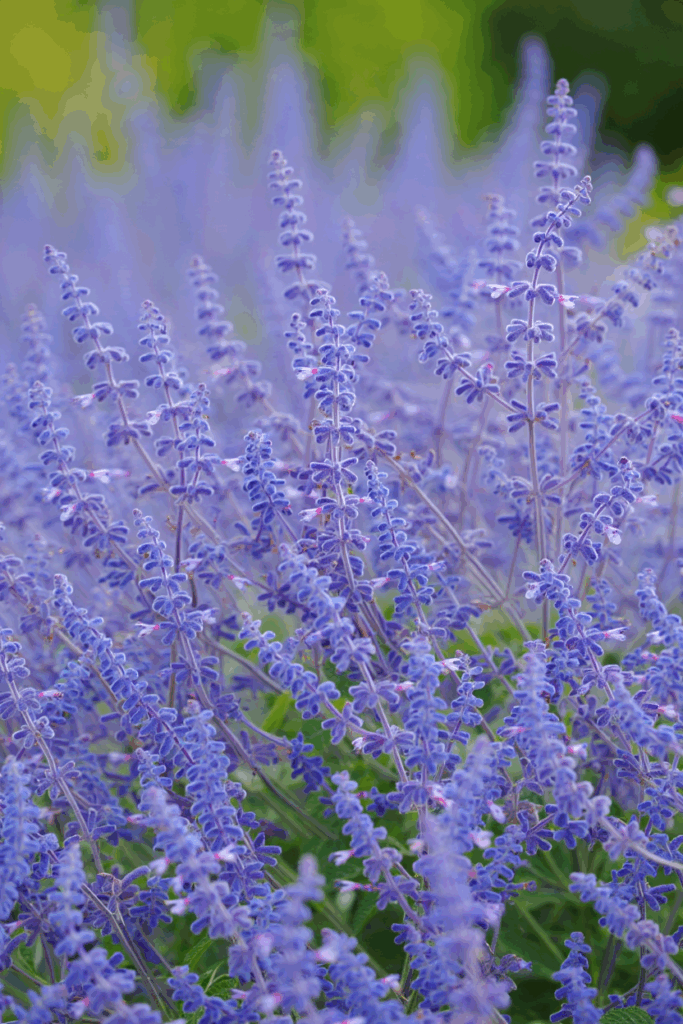
Russian sage has that look every gardener dreams of — silvery stems, lavender-blue flowers, and a breezy, effortless charm that makes it seem indestructible. Every tag says “drought-tolerant,” and technically, it is… just not in the way most people think.
Here’s the truth. Russian sage survives drought, but it doesn’t thrive in it. Those roots sit close to the surface, right where summer heat dries the soil first. Once that top layer bakes, the leaves start to drop, the blooms fade, and the plant begins to look tired instead of ethereal. Even the University of Wisconsin Extension notes that while Russian sage is drought-resistant once it’s established, it still needs regular watering during its first season to build the deep root system that makes it tough later on (University of Wisconsin Extension). And the UC Master Gardener Program adds that this shrub “must be irrigated regularly during the first growing season” to stay healthy (UC Master Gardeners).
Once it’s mature, it can handle a dry spell — but not forever. In long, hot summers, even the toughest clumps appreciate a deep soak every week or two. Think of it like this: Russian sage wants to pretend it’s a desert plant, but deep down it still expects the occasional drink.
A Better Native Alternative – Blue Sage (Salvia farinacea)

If you love that same silvery foliage and cloud of purple blooms, Salvia farinacea (mealy blue sage) is your American-born answer. It’s native to the southern plains and Texas Hill Country, where real drought is part of life. Once established, it keeps blooming through heat and dust without needing constant watering. Bees, butterflies, and hummingbirds adore it, and it stays fresh and upright long after Russian sage has given up for the season.

Written By
Amber Noyes
Amber Noyes was born and raised in a suburban California town, San Mateo. She holds a master’s degree in horticulture from the University of California as well as a BS in Biology from the University of San Francisco. With experience working on an organic farm, water conservation research, farmers’ markets, and plant nursery, she understands what makes plants thrive and how we can better understand the connection between microclimate and plant health. When she’s not on the land, Amber loves informing people of new ideas/things related to gardening, especially organic gardening, houseplants, and growing plants in a small space.
